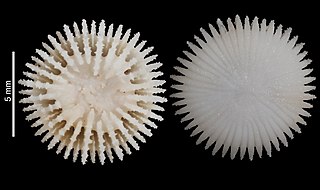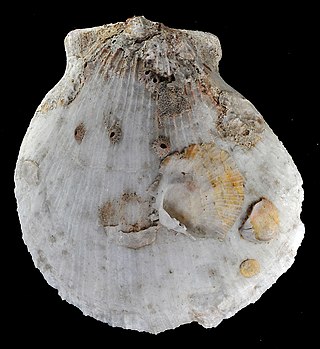
The Phrynosomatidae are a diverse family of lizards, sometimes classified as a subfamily (Phrynosomatinae), found from Panama to the extreme south of Canada. Many members of the group are adapted to life in hot, sandy deserts, although the spiny lizards prefer rocky deserts or even relatively moist forest edges, and the short-horned lizard lives in prairie or sagebrush environments. The group includes both egg-laying and viviparous species, with the latter being more common in species living at high elevations.

Geotrupes is a genus of earth-boring scarab beetles in the family Geotrupidae. There are at least 30 described species in Geotrupes.

Latimeriidae is the only extant family of coelacanths, an ancient lineage of lobe-finned fish. It contains two extant species in the genus Latimeria, found in deep waters off the coasts of southern Africa and east-central Indonesia. In addition, several fossil genera are known from the Mesozoic of Europe, the Middle East, and the southeastern United States, dating back to the Triassic.

Epihippus is an extinct genus of the modern horse family Equidae that lived in the Eocene, from 46 to 38 million years ago.
Arnold John "Jigger" Statz was an American professional baseball player, manager and scout. An outfielder, Statz appeared in 683 games played in Major League Baseball, but had a lengthy and notable minor league career, playing in almost 2,800 games. He is one of only nine players known to have amassed at least 4,000 combined hits in the major and minor leagues. The native of Waukegan, Illinois, threw and batted right-handed, and was listed as 5 feet 7 inches (1.70 m) tall and 150 pounds (68 kg).
Erpetosaurus is an extinct genus of dvinosaurian temnospondyl within the family Eobrachyopidae. Erpetosaurus is only known from the Upper Freeport Coal, Allegheny Group, Middle Pennsylvanian of Linton, Ohio, USA. Some unique features of the temnospondlys are that they have a single fang on each premaxilla on the anterior maxilla for the reception of two dentary fangs; and an elongate, tube-like backside extension of the parasphenoid, both hinting to an aquatic hunting lifestyle.
The Laventan age is a period of geologic time within the Middle Miocene epoch of the Neogene, used more specifically within the SALMA classification in South America. It follows the Colloncuran and precedes the Mayoan age.
"Leptura" longipennis is an extinct species of longhorn beetle that lived in the Oligocene of Germany. It was first described by Georg Statz in 1938, from a fossil of two elytra and a leg found in the Rott Formation. It was originally described as a species of the genus Leptura, but later research has determined it does not belong to that genus, and that it has an uncertain placement in the Lepturinae subfamily.

Pyrrhocoris is a genus of true bugs in the family Pyrrhocoridae, the cotton stainers. Records of occurrence are mainly in the Palaearctic realm, with some from North America and East Asia.
Drosophila elegans is a flower-feeding species of fruit flies, belonging to the family Drosophilidae. It is found in Taiwan and the Philippines in Asia.
Ectrepesthoneura is a genus of fungus gnats in the family Mycetophilidae. There are more than 20 described species in Ectrepesthoneura.

Ilyocoris is a genus of true bugs belonging to the family Naucoridae.

Sphodrosaurus is an extinct genus of basal archosauriform reptiles from the Late Triassic-aged New Oxford Formation of Pennsylvania. The type species is S. pennsylvanicus, described by Edwin Colbert in 1960. The holotype consists of a partial skeleton including the back of the skull, the vertebral column, all of the ribs, all of the hindlimbs and part of the upper forelimbs; Sphodrosaurus was originally believed to have been a member of the Procolophonidae while more recently Sphodrosaurus was believed to be a basal member of the Diapsida by most authors starting with Sues et al. (1993), or a member of the Rhynchosauria. In 2022, Ezcurra & Sues redescribed the holotype in detail and placed it in a phylogenetic analysis with other Triassic diapsid reptiles, where it was found as the basalmost doswellid.

Thanatosdrakon is a genus of quetzalcoatline azhdarchid pterosaur from the Late Cretaceous Plottier Formation of the Neuquén Basin in western Argentina. The genus name is derived from the Greek words thanatos (=death) and drakon (=dragon), while the specific name is a Quechuan word meaning "flying serpent" and refers to the Incan deity Amaru. The type and only species is Thanatosdrakon amaru, known from two specimens consisting of several well-preserved axial and appendicular bones including material previously undescribed in giant azhdarchids. Thanatosdrakon is one of the oldest known members of the Quetzalcoatlinae. T. amaru lived from about 90 to 86 million years ago.
Macraucheniopsis is an extinct genus of litoptern mammal belonging to the family Macraucheniidae from the Middle to Late Pleistocene of Argentina. It, along with Macrauchenia, Neolicaphrium, and Xenorhinotherium were among the youngest known genera of litopterns.

Conoryctella is an extinct genus of taeniodonts from extinct tribe Conoryctellini within extinct subfamily Conoryctinae and extinct family Conoryctidae, that lived in North America during the early Paleocene.

Nick Statz is a Canadian professional football defensive back for the Calgary Stampeders of the Canadian Football League (CFL). He played U Sports football at the University of Calgary.

Anthemiphyllia is a genus of corals within the family Anthemiphylliidae. There are currently 8 extant and 2 extinct species assigned to the genus.

Spondylus candidus is a species of bivalve mollusc within the family Spondylidae. Its distribution covers areas near coasts of Australia and South Africa, and in the Red Sea where it lives in benthic environments at depths of 21 to 75 meters. Fossil occurrences have been found in the Quaternary of Djibouti and in the Miocene of Japan and Vanuatu.











